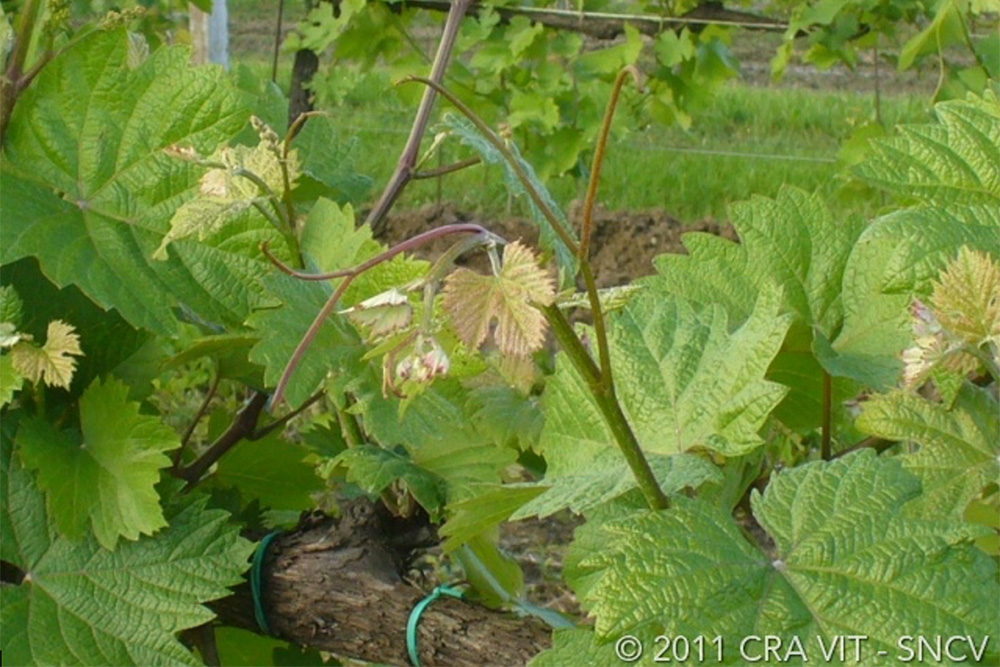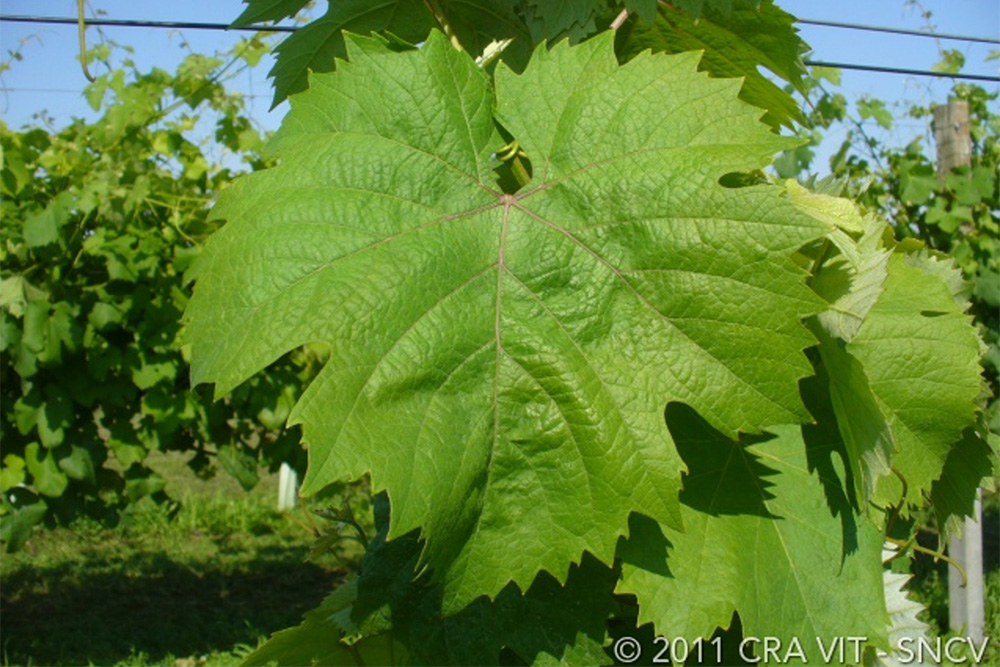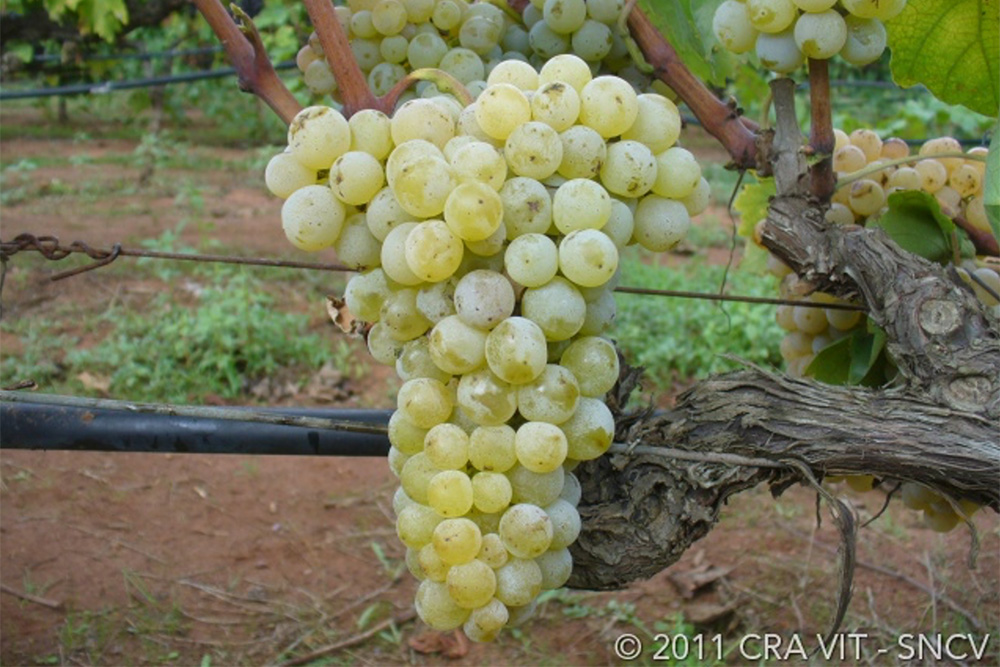-
Jaddico Estate
-
Uggìo-Punta Aquila Estate
-
The Ostuni vineyard
-
Palombara Estate
-
Padula di Geremia Estate
-
Torre Testa
-
Visellio
-
V’itra
-
Jaddico
-
Palombara
-
Oltremé
-
Miraglio
-
Punta Aquila
-
Lamo
-
Sumaré 27 months
-
Sumaré 60 months
-
Salende
-
Libens
-
Lamiro
-
Giancòla
-
Saturnino
-
Oltremé Rosato
-
Torre Testa Rosato
-
Aleatico
-
Aspettando San Martino
-
Cantine Aperte
-
La Vendemmia delle donne
-
RAP
-
Rubino Wine Party
-
Saturnino Wine Party
-
Tenute Rubino Wine & Friends
Bianco d’Alessano
Name and history
Verdurino, “Acchiappapalmento”. Rovasenda mentions other synonyms such as “Bianco di Lessame”


Ampelographic Description
The study was conducted in a vineyard located in Martina Franca, in the “Cappuccio” district,
owned by Mr. Martino Cesare.
Shoot 10-20 cm long
Apex: expanded, woolly, with a carmine-colored edge.
Apical leaflets (1st to 3rd): unfolded, woolly, green with carmine-colored edges.
Basal leaflets (from the 4th onward): unfolded, woolly, green with brownish hues.
Shoot axis: slightly curved.
Herbaceous shoot: circular cross-section with angular outline, arachnoid, green,
with large nodes.
Tendrils: long, bifid and trifid, green with reddish hues, intermittent; formula 0-1-2-0.
Inflorescence: medium-sized, winged shape.
Flower: cylindrical floral bud, medium-sized, hermaphroditic, self-fertile.
Leaf: medium to large size; orbicular, 3 to 5-lobed; petiolar sinus V- or U-shaped,
lateral sinuses V-shaped or lyre-shaped; upper surface glabrous, dark green, dull, veins
green with a slight reddish tinge at the base; lower surface light green, woolly, with
prominent 1st- and 2nd-order veins; blade flat with slightly wavy surface, fairly thick;
lobes flat, with acute angles at the tips of the terminal lobes; lateral teeth irregular,
pronounced, convex with a broad base.
Petiole: medium in length and thickness, arachnoid, slightly wine-red in color, with a
cross-section showing a faintly visible groove.
Leaf coloration in autumn: yellow.
Cluster at industrial ripeness: conico-cylindrical in shape, simple or winged,
compact in appearance, 18–25 cm long, with a medium to thick, visible peduncle;
short, green pedicel, difficult to detach from the berry; noticeable disk (cushion),
green; short brush, light green tending toward yellow.
Berry: regularly spheroid, medium-sized (12–15 mm), with a persistent navel; circular
cross-section, thick, pruinose skin, uniformly yellow in color; juicy pulp with a neutral
flavor.
Seeds: average of 2–3 per berry, medium-sized, pear-shaped, with a long, slender
beak, light brown in color.
Woody shoot: medium in length, glabrous, hazel-colored; striated surface; branched;
nearly circular cross-section; nodes slightly flattened; internodes 7–12 cm, uniformly
colored; buds conical and prominent; petiolar scar broad and protruding. Diaphragm
convex.
Trunk: very vigorous.


Phenology
Observation conditions.
Location.
Longitude: 17°25’ E;
Latitude: 40°38’ N;
Altitude: 405 m s.l.m.;
Exposure: southeast;
Rootstock: “Riparia X Rupestris 3309”;
Vine age: 5 years;
Training system: medium expansion, low, with rich pruning;
Pruning form: mixed, Pugliese tree form with 3-4 spurs and a fruiting head with 7
or more buds;
Soil: hilly, clay-siliceous-limestone, moderately deep.
Vegetative phenomena.
Bud break: April 10–20;
Flowering: second half of May;
Veraison: second half of August;
Grape ripening: second half of September to October 10;
Leaf fall: November.
Cultural Characteristics and Suitability
Vigor: normal;
Production: abundant (in young vineyards, 40 q/ha; can reach 60–70 q/ha);
Position of the first fruiting shoot: 2nd and 3rd node;
Average number of inflorescences per shoot: 1-2;
Fertility of the female flowers: almost none;
Resistance to pests and other adversities: good; poor fruit set in adverse years;
somewhat resistant to powdery mildew and downy mildew, not resistant to frost like
Verdeca;
Behavior with respect to grafting: normal;
Affinity for rootstocks: Berl x Rip 420A and 157/11 Rip X Rup 3309 and 3306 used
in the area.


Utilization
Exclusively for winemaking. The “Bianco d’Alessano” combined with “Verdeca”
produces the typical wine of Martina Franca with 11–12° alcohol, neutral taste, and
medium fixed acidity of 5‰.